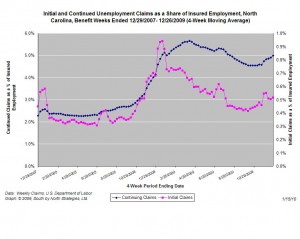18.01.2010
Policy Points
From the U.S. Bureau of Labor Statistics’ report on changes in the consumer price index in December 2009:
On a seasonally adjusted basis, the December Consumer Price Index for All Urban Consumers (CPI-U) rose 0.1 percent, the U.S. Bureau of Labor Statistics reported today. Over the last 12 months, the index increased 2.7 percent before seasonal adjustment.
…
The seasonally adjusted increase in the all items index was broad based, with the indexes for food, energy, and all items less food and energy all posting modest increases. Within the latter group, a sharp rise in the index for used cars and trucks was the largest contributor to the 0.1 percent increase, while the indexes for airline fares, apparel, and lodging away from home rose as well. In contrast, the indexes for rent and owners’ equivalent rent were unchanged and the index for new vehicles declined.
In an analysis of the data, economist David Rosnick of the Center for Economic and Policy Research observes that low levels of consumer price inflation in recent months are attributable to the fallout from the housing bubble. Writes Rosnick:
After three months of decline, the price indices for rent and owner’s equivalent rent each remained flat in December. The oversupply of housing resulting from the housing bubble mean these components have been a significant source of price restraint overall. The non-rent core CPI grew at an annualized rate of 2.5 percent over the last six months compared to 1.3 percent in the overall core.
…
The fall in rents has been particularly pronounced in the South. In Washington, DC, where real house prices have fallen more than 34 percent since the peak in early 2006, (non-seasonally-adjusted) rents have fallen at a 1.2 percent rate since September. In Miami, rents are falling at a 2.6 percent annualized rate, having seen a 50 percent fall in real house prices. Atlanta, where the housing bubble was less pronounced (having fallen 24 percent in two years), has seen rent fall at a 4.7 percent rate over the last three months.
15.01.2010
Policy Points
A round-up of policy reports from the week ending on 1/15:
15.01.2010
Policy Points
For the benefit week ending on December 26th, 34,172 North Carolinians filed initial claims for state unemployment insurance benefits, and 219,701 individuals applied for state-funded continuing insurance benefits. Compared to the prior week, there were fewer initial and continuing claims. (Note the filing week had fewer business days due to the New Year’s holiday.) These figures come from data released today by the U.S. Department of Labor.
Averaging new and continuing claims over a four-week period — a process that helps adjust for seasonal fluctuations and better illustrates trends — shows that an average of 20,405 initial claims were filed over the last four weeks, along with an average of 197,495 continuing claims. Compared to the previous four-week period, both initial and continuing claims were higher.

One year ago, the four-week average for initial claims stood at 27,290 and the four-week average of continuing claims equaled 166,264.
The graph (right) shows the changes in unemployment insurance claims (as a share of covered employment) in North Carolina since the recession’s start in December 2007.
Although new and continuing claims appear to have peaked for this business cycle, the claims levels remain elevated and point to a labor market that remains extremely weak. Especially troubling is the high level of continuing claims, which suggests that unemployed individuals are finding it extremely difficult to find new positions.
15.01.2010
Policy Points
From the Federal Reserve Bank of Richmond’s December survey of service-sector activity in the South Atlantic (District of Columbia, Maryland, North Carolina, South Carolina, Virginia and West Virginia):
Activity in the service sector remained weak in December, according to the latest survey by the Federal Reserve Bank of Richmond. Retail sales dropped sharply, led by falling big-ticket sales, and shopper traffic declined. Retail inventory contraction slowed. Revenues at services firms also fell in December. Looking ahead six months, however, survey respondents were optimistic about business prospects.
…
In service sector labor markets, job cuts increased at retail establishments and services firms. Average wages in the sector were unchanged, compared to a month ago, and price growth was mild. For the six months ahead, survey respondents expected modest price growth.
14.01.2010
Policy Points
Economic policy reports, blog postings, and media stories of interest:


 Email Sign-Up
Email Sign-Up RSS Feed
RSS Feed